剑桥二
剑桥少儿英语2级
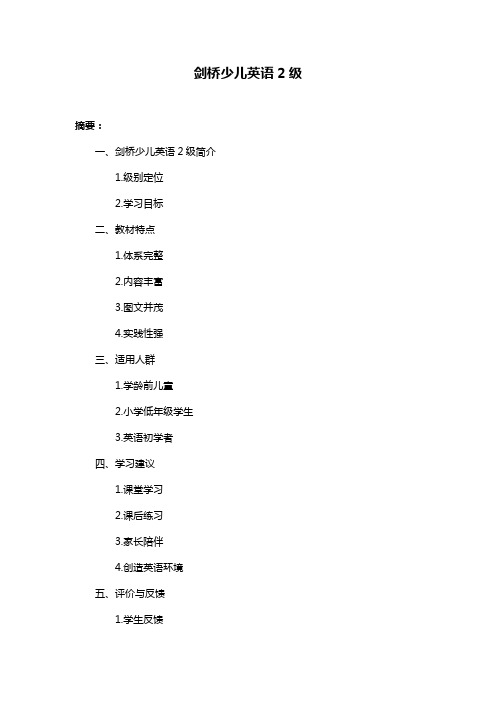
剑桥少儿英语2级摘要:一、剑桥少儿英语2级简介1.级别定位2.学习目标二、教材特点1.体系完整2.内容丰富3.图文并茂4.实践性强三、适用人群1.学龄前儿童2.小学低年级学生3.英语初学者四、学习建议1.课堂学习2.课后练习3.家长陪伴4.创造英语环境五、评价与反馈1.学生反馈2.家长评价3.教师评价正文:一、剑桥少儿英语2级简介剑桥少儿英语2级是针对学龄前儿童和小学生设计的英语课程,旨在帮助学生在轻松愉快的氛围中学习英语,提高他们的英语综合素质。
这个级别定位在小学低年级阶段,适合有一定英语基础的学生学习。
二、学习目标剑桥少儿英语2级的学习目标包括:能听懂、会说、认读、书写简单的英语单词和句子;掌握基本的英语语法和语音知识;能进行简单的英语交流;培养良好的英语学习习惯和兴趣。
三、教材特点1.体系完整:剑桥少儿英语2级的教材从听、说、读、写四个方面全面培养学生,形成了一套完整的学习体系。
2.内容丰富:教材涵盖了日常生活、学习、娱乐等多个方面,内容丰富多样,让学生在轻松愉快的氛围中学习英语。
3.图文并茂:教材配有精美的插图,激发了学生的学习兴趣,同时也帮助他们更好地理解课文。
4.实践性强:教材设计了大量的实践活动,让学生在实际操作中学习英语,提高他们的英语应用能力。
四、适用人群剑桥少儿英语2级适合以下人群:1.学龄前儿童:通过学习这个级别的英语,可以为入学后的英语学习打下基础。
2.小学低年级学生:这个阶段的学生具有较强的模仿力和学习能力,适合学习简单的英语知识。
3.英语初学者:无论成年人还是孩子,都可以通过这个级别的学习,入门英语。
五、学习建议1.课堂学习:学生在课堂上跟随老师学习英语知识,参与互动活动,提高英语听说能力。
2.课后练习:学生应在课后进行适量的练习,巩固课堂所学知识,提高英语读写能力。
3.家长陪伴:家长应积极参与孩子的英语学习,陪伴他们完成课后作业,提高学习效果。
4.创造英语环境:尽量让孩子置身于英语环境中,如观看英语动画片、听英语歌曲等,培养孩子的英语语感。
剑桥少儿英语二级上unit2

学习过程中的注意事项
注重听说训练:多 听多说,提高英语 听说能力
培养兴趣:通过游 戏、歌曲等方式激 发学习兴趣
坚持练习:每天安 排一定的学习时间 ,养成良好学习习 惯
家长参与:鼓励家 长与孩子一起学习 ,创造良好的英语 学习环境
学习后的巩固和提高
练习听说能力: 通过模仿、跟 读、对话等方 式,提高听说
培养孩子的英语 语法和词汇能力, 使他们能够掌握 常用的英语单词 和短语。
剑桥少儿英语二级的教学内容
掌握约370个词汇和短语
学习基本语法和句型结构
提高听、说、读、写四项 技能
培养英语学习兴趣和实际 应用能力
剑桥少儿英语二 级unit2的课程
设置
主题:动物
unit2的主题
词汇的构成和 用法
了解现在进行时的基本概念和 用法
如何学习剑桥少 儿英语二级 unit2
学习前的准备
了解剑桥少儿英语二级unit2的学习内容和要求
准备学习材料,如教材、练习册、听力材料等
制定学习计划,安排每天的学习时间和进度 确定学习方法和策略,如听说读写各项技能的练习、记忆单词和语法规则 等
针对评估结果的改进措施
针对听力理解:加强听力训 练,提高孩子的听力水平
针对阅读理解:增加阅读量, 提高孩子的阅读速度和阅读 理解能力
针对口语表达:提供更多的 口语练习机会,鼓励孩子多 说多练
针对写作能力:加强写作训 练,提高孩子的写作技巧和
表达能力
感谢您的观看
汇报人:XX
完成课程配套练 习和测试
参加剑桥少儿英 语等级考试
评估结果的分析和反馈
分析评估结果:根据考试成绩和其他评估指标,分析学生的学习状况和 需要改进的方面。
剑桥国际少儿英语第二册

剑桥国际少儿英语第二册单词单词发音解释例句1 one[wʌn]n.一They have one daughter. 他们有一个女儿。
2 two[tuː]n.二I have two rulers. 我有两个尺子。
3 three[θriː]n.三She had three tries and failed each time. 她试了三回,每回都失败了。
4 four[fɔː]n.四I have four apples. 我有四个苹果。
5 five[faɪv]n.五I have five pears. 我有五个梨子。
6 six[sɪks]n.六I have six watermelons. 我有六个西瓜。
7 seven['sev(ə)n]n.七He was in a coma for seven weeks. 他已经昏迷七个星期了。
8 eight[eɪt]n.八I have eight pineapples. 我有八个菠萝。
9 nine[naɪn]n.九He has nine lemons. 他有九个柠檬。
10 ten[ten]n.十I have ten apples. 我有十个苹果。
11 red[red]n.红色 adj.红色的Do you like red? 你喜欢红色吗?12 yellow['jeləʊ]n.黄色 adj.黄色的I like the yellow shirt. 我喜欢黄色的衬衫。
13 pink[pɪŋk]n.粉色 adj.粉色的I like pink. 我喜欢粉红色。
14 green[griːn]n.绿色 adj.绿色的My bag is green. 我的包是绿色的。
15 orange['ɒrɪn(d)ʒ]n.柑橘;橙Which fruit do you like, the banana or the orange? 你喜欢哪种水果,是香蕉还是橙子?16 blue[bluː]n.蓝色 adj.蓝色的My schoolbag is blue. 我的书包是蓝色的。
剑桥标准英语教程2难度

剑桥标准英语教程2难度剑桥标准英语教程2是一本专门为英语学习者设计的教材,它主要面向初学者和中级学习者,难度适中,内容涵盖了日常生活中常用的英语场景和词汇,是一本非常实用的教材。
在学习这本教材的过程中,可能会遇到一些困难和挑战,但只要我们坚持不懈,一定能够取得良好的学习效果。
首先,剑桥标准英语教程2的难度主要体现在词汇量和语法知识上。
对于初学者来说,掌握大量的词汇是一项具有挑战性的任务。
在学习过程中,我们可以通过多听、多读、多写、多说的方式来巩固词汇,例如可以利用单词卡片、背诵词汇书籍等方式来提高词汇量。
此外,教材中的语法知识也是学习者需要重点关注的内容,例如时态、语态、句型转换等,这些知识点需要我们反复练习和总结,才能够熟练掌握。
其次,剑桥标准英语教程2还涉及到听力和口语的训练。
对于很多学习者来说,英语的听力和口语能力是一个相对薄弱的环节。
在学习教材的过程中,我们可以通过大量的听力训练来提高自己的听力水平,例如可以听英语广播、英语新闻、英语歌曲等。
同时,我们也可以通过模仿和练习来提高口语表达能力,可以找一些语伴进行对话练习,或者参加英语角、英语演讲比赛等活动,来提高自己的口语水平。
最后,剑桥标准英语教程2还要求学习者具备一定的阅读和写作能力。
在学习过程中,我们可以多读一些英语文章、英语故事,来提高自己的阅读能力,同时也可以多写一些英语作文、英语日记,来提高自己的写作能力。
通过不断地练习和积累,我们一定能够取得进步。
总的来说,剑桥标准英语教程2的难度适中,对于初学者和中级学习者来说是一本非常实用的教材。
在学习过程中,我们要注重词汇量和语法知识的积累,同时也要注重听力和口语的训练,还要具备一定的阅读和写作能力。
只有通过不懈的努力和坚持,我们才能够取得良好的学习效果,提高自己的英语水平。
希望大家都能够在学习英语的道路上取得成功,不断进步!。
剑桥think2教材内容
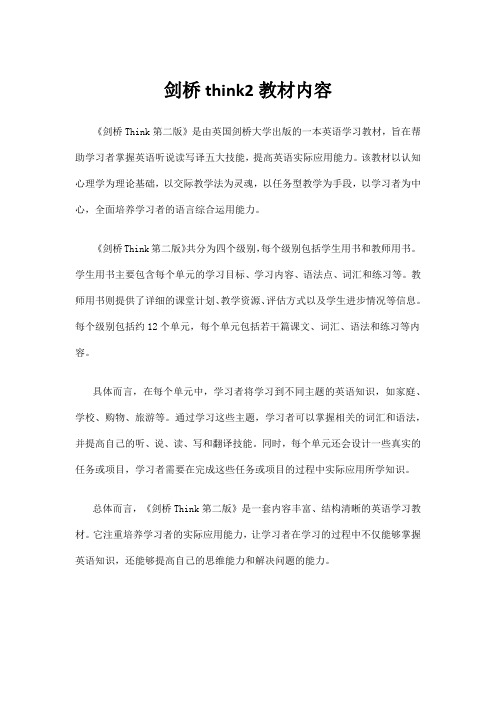
剑桥think2教材内容
《剑桥Think第二版》是由英国剑桥大学出版的一本英语学习教材,旨在帮助学习者掌握英语听说读写译五大技能,提高英语实际应用能力。
该教材以认知心理学为理论基础,以交际教学法为灵魂,以任务型教学为手段,以学习者为中心,全面培养学习者的语言综合运用能力。
《剑桥Think第二版》共分为四个级别,每个级别包括学生用书和教师用书。
学生用书主要包含每个单元的学习目标、学习内容、语法点、词汇和练习等。
教师用书则提供了详细的课堂计划、教学资源、评估方式以及学生进步情况等信息。
每个级别包括约12个单元,每个单元包括若干篇课文、词汇、语法和练习等内容。
具体而言,在每个单元中,学习者将学习到不同主题的英语知识,如家庭、学校、购物、旅游等。
通过学习这些主题,学习者可以掌握相关的词汇和语法,并提高自己的听、说、读、写和翻译技能。
同时,每个单元还会设计一些真实的任务或项目,学习者需要在完成这些任务或项目的过程中实际应用所学知识。
总体而言,《剑桥Think第二版》是一套内容丰富、结构清晰的英语学习教材。
它注重培养学习者的实际应用能力,让学习者在学习的过程中不仅能够掌握英语知识,还能够提高自己的思维能力和解决问题的能力。
剑桥国际少儿英语第二版听力原文

剑桥国际少儿英语第二版听力原文Cambridge Young Learners English Tests Second Edition Listening ScriptsThe Cambridge Young Learners English Tests Second Edition is a widely recognized assessment program designed to evaluate the English language proficiency of young learners. The listening component of these tests is a critical aspect that assesses the ability of students to comprehend spoken English in a variety of contexts. The listening scripts, which provide the specific audio recordings used in the tests, offer valuable insights into the range and complexity of the language presented to these young learners.One of the key features of the Cambridge Young Learners English Tests Second Edition listening scripts is the diversity of topics and scenarios covered. The scripts encompass a wide range of subject matter, from everyday conversations and instructions to more academic and formal discussions. This diversity not only challenges the students' listening comprehension skills but also exposes them to the versatility of the English language in different contexts.The listening scripts are carefully crafted to align with the languageproficiency levels of the young learners. At the lower levels, the scripts feature simple vocabulary, clear pronunciation, and uncomplicated sentence structures, allowing beginners to gradually build their listening comprehension skills. As the proficiency levels increase, the scripts become more complex, incorporating more advanced vocabulary, complex grammatical structures, and faster speech patterns, pushing the students to develop their listening skills further.Another important aspect of the Cambridge Young Learners English Tests Second Edition listening scripts is the inclusion of various accents and speaking styles. The scripts feature speakers with different regional and national accents, exposing the students to the diversity of English pronunciation and intonation patterns. This exposure not only prepares the students for real-world communication but also fosters their ability to adapt to different speaking styles and accents.The listening scripts also cover a range of common conversational scenarios, such as introductions, requests, instructions, and discussions. By presenting these scenarios in an engaging and realistic manner, the scripts help students develop their ability to comprehend spoken English in everyday situations, which is crucial for their overall language development and practical application.Furthermore, the Cambridge Young Learners English Tests Second Edition listening scripts often incorporate interactive elements, such as question-and-answer segments or follow-up tasks. These interactive components not only assess the students' listening comprehension but also encourage active engagement and critical thinking, essential skills for successful language learning.In conclusion, the Cambridge Young Learners English Tests Second Edition listening scripts play a pivotal role in the assessment and development of young learners' English language proficiency. By presenting a diverse range of topics, language proficiency levels, accents, and conversational scenarios, the scripts challenge and empower students to enhance their listening comprehension skills, preparing them for effective communication in a globalized world.。
剑桥少儿英语二级movers 2 Speaking 备考专项

Speaking part 3 每组图中,找出一个不同
作答要求与规范:
Part3需要把每道题目里的四幅图片的名词都说出来,不要用this, that去代 替它们的名称, 例题:图片给的是电影院,办公室,学校,图书,让考生找不同。 考生应该说Book is different. Cinema, office and school are places, but book isn't.
(指着男生掉落的书)The boy's book is falling off, but here the scarf is falling off.(得分点+1)
Speaking part 2 依次按照顺序描述图片
作答要求与规范: 1.要求考生快速浏览图片,考官讲解故事开头,考生按照顺序讲述故事。 回答模板: 描述动作,情绪状态如何? 例如:Clare has got many presents. She's very happy。
Part 3 考官:Look at these four pictures. One is different. The book is different. A lemon, a pineapple, and an orange are fruit. You eat them. You don’t eat fruit. You don’t eat a book. You read it. Now you tell me about these pictures. Which one is different. (考官示范第一组后,考生讲解剩余四组,找出不同的 一类,并作解释,只要合理即可,没有标准答案,以下 作答仅供参考) 考生: (第二组)The penguin is different. A penguin is the bird, but a kangaroo, a bear and a rabbit aren’t birds. (第三组)The sitting girl is different. He is washing hands, and she’s washing face and he’s washing hair. But this girl is sitting and drinking. (第四组)The boy is different. The man is watching TV in the living room, and the woman is cooking in the kitchen, and the girl is reading in the bedroom. They are all inside of the house, but the boy is playing football outside.
剑桥标准英语教程2难度

剑桥标准英语教程2难度
剑桥标准英语教程2是一本专门为学习者提供英语学习指导的教材,它的难度
适中,涵盖了丰富的语法知识和丰富的词汇量。
在学习这本教材时,学习者需要付出一定的努力和时间,但同时也会获得丰富的知识和提高英语水平的机会。
首先,剑桥标准英语教程2的难度主要体现在语法知识的学习上。
在这本教材中,学习者将接触到更加复杂的句型结构和语法规则,需要通过大量的练习来巩固和掌握这些知识。
例如,学习者将学习到不同时态的用法、虚拟语气的表达、从句的运用等等,这些内容对于初学者来说可能会有一定的挑战,需要反复地学习和练习才能掌握。
其次,词汇量的积累也是剑桥标准英语教程2的难点之一。
在这本教材中,学
习者将接触到更加丰富和具体的词汇,涉及到各个领域的专业术语和常用词汇。
学习者需要通过大量的阅读和实践来扩展自己的词汇量,同时也需要学会如何正确地运用这些词汇来表达自己的意思。
这对于学习者来说是一个不小的挑战,但也是一个提高英语水平的重要环节。
此外,剑桥标准英语教程2还要求学习者具备一定的阅读能力和语言表达能力。
在学习过程中,学习者需要通过阅读大量的文章和课文来提高自己的阅读理解能力,同时也需要学会如何用英语清晰地表达自己的意思。
这对于学习者来说是一个全方位的提高,需要不断地练习和实践才能达到较高的水平。
总的来说,剑桥标准英语教程2的难度适中,对于学习者来说是一个很好的提
高英语水平的机会。
在学习过程中,学习者需要付出一定的努力和时间,但同时也会获得丰富的知识和提高英语水平的机会。
希望学习者在学习过程中能够克服困难,不断提高自己的英语水平,取得更好的学习成绩。
剑桥二年级上册单元重点知识总结
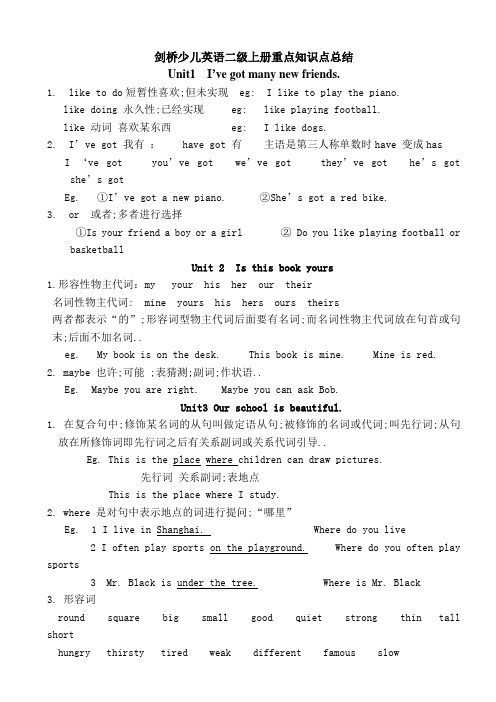
剑桥少儿英语二级上册重点知识点总结Unit1 I’ve got many new friends.1. like to do短暂性喜欢;但未实现 eg: I like to play the piano.like doing 永久性;已经实现 eg: like playing football.like 动词喜欢某东西 eg: I like dogs.2. I’ve got 我有: have got 有主语是第三人称单数时have 变成hasI ‘ve got you’ve got we’ve got they’ve got he’s gotshe’s gotEg. ①I’ve got a new piano.②She’s got a red bike.3. or 或者;多者进行选择①Is your friend a boy or a girl ② Do you like playing football orbasketballUnit 2 Is this book yours1.形容性物主代词:my your his her our their名词性物主代词: mine yours his hers ours theirs两者都表示“的”;形容词型物主代词后面要有名词;而名词性物主代词放在句首或句末;后面不加名词..eg. My book is on the desk. This book is mine. Mine is red.2. maybe 也许;可能 ;表猜测;副词;作状语..Eg. Maybe you are right. Maybe you can ask Bob.Unit3 Our school is beautiful.1. 在复合句中;修饰某名词的从句叫做定语从句;被修饰的名词或代词;叫先行词;从句放在所修饰词即先行词之后有关系副词或关系代词引导..Eg. This is the place where children can draw pictures.先行词关系副词;表地点This is the place where I study.2. where 是对句中表示地点的词进行提问;“哪里”Eg. 1 I live in Shanghai. Where do you live2 I often play sports on the playground. Where do you often play sports3 Mr. Black is under the tree. Where is Mr. Black3. 形容词round square big small good quiet strong thin tall shorthungry thirsty tired weak different famous slow4. which 哪个;哪些;在很多的当中;挑选一个最具有特征或多个有代表性的eg. ① Which word is loud ② Which word is not fatUnit4 Miss; can I ask you a question1、 can 能;会;后跟动词原形;无论主语是单数还是复数..Eg. ①I can swim. ②She can sing.变疑问句把can放于最前面;有两种回答方式;肯定回答和否定回答..---Can I have an ice cream ---Yes; you can. / No; you can’t.2 、may表示请求;许可;意为“可以” Eg. ①May I sit here ② May I come in表示推测;常用于肯定句;意为可能;也许.Eg; It may rain tomorrow.3、短语①Well done 做的好②Of course 当然.③Mop the floor . 拖地④Bounce the ball .拍球.Unit 5 How about coming with us1.How about =What about 用来询问消息或征求意见;表示……怎么样常见句型有:①What about +名词/介词②What about+动词的ing形式③What about something to eat2. be going to 打算;计划做某事①be随人称变化而变化②be going to +动词原形③ be going to+ 地点3. would like 想要:①Would like +名词②would like +to do肯定回答:Yes; I’d like to. Yes; I’d love to.否定回答:No; thanks.4. have fun 过的愉快;玩的高兴5. Enjoy the holiday 假期愉快Uint 6 He likes reading picture books.1. ①like +doing sth ②like to do sth注意人称的变化: Eg. ① I like dancing. ② He likes dancing.否定句: Eg. ①I don’t like... ②He doesn’t like…2.It’s time to 到了……时间了. Eg. It’s time to g home /get up.3.be ready for sth/to do sth 准备好…Eg. I’m ready to start work.4.①play +球类;棋牌;游戏② play +the 乐器play football play the piano5.by the way 顺便说一下6. right now=at once =right away 立刻;马上Unit7 You mustn’t drop litter in the park1.must /mustn’t +动词原形必须/禁止2. there be 结构表示某地有某物There be +主语+时间或地点状语否定形式在be 后加not;问句把be 提前;be 随主语的人称和时态的变化而变化;若有两个或更多的主语谓语动词常取就近原则..Eg. ①There is a little water in the glass.②There are a lot of trees on the each side of the road.3.thow …at 向……扔去Eg. You mustn’t throw food at animals.Unit 8 Who is the winner1.How many +可数名词复数+are there +其他How many books are there in your bag 回答:There are /is…Unit9 Sally is taller than Ben.1.形容词比较级规则变化:1一般情况下直接加er; long-----longer short----shorter strong----stronger2以e结尾的形容词在词尾之加r; late----later nice----nicer fine----finer3以辅音字母加y 结尾的形容词;变y为i 再加er;Eg: dirty----dirtier easy----easier happy----happier 4以一个辅音字母结尾的重读闭音节形容词;要双写该辅音字母再加erEg: big----bigger thin----thinner hot----hotter5部分双音节词和多音节词在形容词前加more构成比较级Eg: beautiful----more beautiful careful----more careful2.不规则变化的形容词的比较级:good----better many----more bad----worse3.形容词比较级的用法:用于二者之间的比较A+beis /was+比较级形容词+thanBEg. This pencil is longer than that one.Fred is taller than Tom.4.四位数的读法:1169 one thousand ; one hundred and sixty-nine1598 one thousand ; five hundred and ninety-eight5. A+be+as +形容词+as B A和B一样……Eg.① It is as tall white as snow. ② Her face is as red as an apple.Unit10 Did you know1.形容词的最高级规则变化:1一般情况在词尾加est; eg: long----the longest short----the shortest2以e结尾的形容词在词尾加st;eg: fine----the finest late----the latest3以辅音字母加y结尾的形容词;变y为i再加est;Eg: dirty----the dirtiest happy----the happiest4以一个辅音字母结尾的重读闭音节词;要双写该辅音字母再加estEg: big----the biggest fat----the fattest5部分双音节和多音节形容词;通常在形容词前加the most 构成最高级;Eg: beautiful----the most beautiful difficult----the most difficult2.形容词最高级的用法啊:用于三者或三者以上的比较..① A +beis /was+the 形容词的最高级+单数名词+比较范围Eg. The Yangtze river is the longest river in China.London is the biggest city in Britain.② A+beis/was +one of +the +最高级形容词+复数名词+比较范围Eg. Sue is one of the thinnest girls in my class.Beijing is one of the most beautiful cities in the world.3.Which…is the +形容词的最高级Eg. Which girl is the tallest Which boy is the fattest4. How tall are you你多高Unit11 I went to the zoo yesterday.1. 一般过去时的用法:表示过去的状态或动作;常与表示时间的状语连用;如yesterday ;two days ago; last week;in1998等..Eg. I saw a film last week.We had a good time yesterday.2. 一般过去时中;除be 动词外;其他动词都没有人称和数的变化..1 be 第一人称单数 I 和第三人称he;she ;it 用was ;其余人称we ;you; they都用had2 动词have都用had3 行为动词一般用过去式;没有人称和数的变化3.动词过去式的规则变化:1 一般在动词原形后加ed: play----played colour----coloured2 以e 结尾的动词加ed : dance----danced like----liked3 以辅音字母加y 结尾的动词;要变y为i再加ed:carry----carried cry----cried4重读闭音节以一个辅音字母结尾的动词需双写该辅音字母再加eg: hop----hopped stop----stopped4.不规则变化动词的过去式:see----saw give----gave ride----rodespeak----spoke take----took buy----bought相见练习册P1005.一般过去时的特殊疑问句:What did you do yesterday肯定句: I saw a film.一般疑问句:Did you saw a film yesterday肯定回答: Yes; I did.否定回答:No; I didn’t.6.not at all 一点也不eg. I don’t like this book at all.I didn’t go out at all.7.down the stairs 下楼 up the stairs 上楼Unit 12 Has your school got a swimming pool1. 现在完成时用法:1表示过去发生的对现在有影响的动作或事情Eg. I have seen the film many times.表示过去某一时间开始一直延续到现在的动作..Eg. He has lived here for seven years.构成:have/has +动词的过去分词2.现在完成时的一般疑问句:have/has +主语+动词的过去分词Eg. Have you got an English book Has your family got a TV3.动词的原形、过去式和过去分词的变化形式有五种:1A—A--A 型 put –put – put放2A—A—B型 beat—beat –beaten 打3A—B—A型 come—came--come来4A—B—B 型 have—had--had有5A—B--C型 do – did—done 做相见课本P69列表4.have been to 去过某地 have ever been to 曾经去过某地 Have never been to 从未去过某地Eg I have ever been to Beijing. I have never been to Hainan.Unit 13 My seven days.1、Days of the week: Monday; Tuesday; Wednesday; Thursday; Friday; Saturday; Sunday.2、Be a good learner 做一个好的初学者..Be a good listener. 做一个好的听众..Be a good footballer. 做一个好的球员..Be a good player. 做一个好的运动员或队员..Be a good painter. 做一个好的油画家..Be a nice friend. 做一个好朋友..Be a fun maker. 做一个好的制造者..3、put on 上演 may be 或许 kick off 中线开球 next to 紧挨着 in front of 在……前面4、Grammer: enjoy doing sth. 结构enjoy + 动+ ingUnit 14 how often does he have sports1、Phrases: see a film看场电影 take a bus / car / taxi 乘坐……2、Main sentences:How often do you take a carHow often do they walk to schoolUnit 15 I enjoy reading picture stories1、phrases: at the market在市场上 fall down掉下来 take pictures捉迷藏grammer: ask sb to do sth 让某人做某事 give sth to sb= give sb sth 给某人某物Talk about sth 谈论某事 eg: I like / enjoy talk with friends.Like / enjoy + doing sthUnit 16 Water fun1、Phrases:winter fun 冬趣 get up 起床 have a good time 玩的开心2、Grammer: how about doing sth做…事怎么样。
剑桥少儿英语第二级别
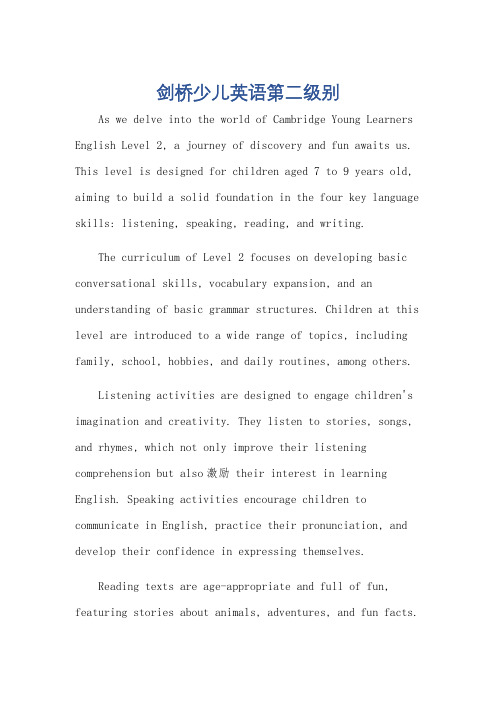
剑桥少儿英语第二级别As we delve into the world of Cambridge Young Learners English Level 2, a journey of discovery and fun awaits us. This level is designed for children aged 7 to 9 years old, aiming to build a solid foundation in the four key language skills: listening, speaking, reading, and writing.The curriculum of Level 2 focuses on developing basic conversational skills, vocabulary expansion, and an understanding of basic grammar structures. Children at this level are introduced to a wide range of topics, including family, school, hobbies, and daily routines, among others. Listening activities are designed to engage children's imagination and creativity. They listen to stories, songs, and rhymes, which not only improve their listening comprehension but also激励 their interest in learning English. Speaking activities encourage children to communicate in English, practice their pronunciation, and develop their confidence in expressing themselves.Reading texts are age-appropriate and full of fun, featuring stories about animals, adventures, and fun facts.These texts help children develop their reading comprehension skills while also expanding their vocabulary. Writing activities, on the other hand, focus on basic handwriting skills, sentence structure, and narrative writing.What makes Cambridge Young Learners English Level 2 stand out is its emphasis on real-life applications. Children are encouraged to use English in real-world situations, such as shopping, greeting people, and introducing themselves. This approach makes learningEnglish not just about scoring well on exams but also about being able to use the language effectively in daily life.The materials used in Level 2 are vibrant, colorful,and engaging, making learning fun and exciting for children. The combination of interactive games, puzzles, andactivities keeps them engaged and motivated to learn more.Moreover, the curriculum is designed to cater to the different learning styles and paces of children. Itprovides opportunities for individual learning, group work, and teacher-led activities, ensuring that every child hasthe chance to excel and reach their full potential.In conclusion, Cambridge Young Learners English Level 2 is a comprehensive and engaging program that equipschildren with the necessary language skills and confidenceto excel in English. It not only focuses on academic achievement but also on fostering a love for learning and a lifetime of language learning.**剑桥少儿英语第二级别的探索之旅**当我们深入探索剑桥少儿英语第二级别时,一场充满发现与乐趣的旅程正在等待我们。
剑桥英语二目录及每单元语法要点

剑桥英语二目录Unit1 A time to remember.Grammar focus: 1) 一般过去时 2) used toUnit2 Caught in the rush.Grammar focus: 1) 表示数量的副词(too many\much, fewer\less, more,enough)2) indirect questions from wh- (宾语从句)Unit3 Time for a change!Grammar focus: 1) 评价&比较(adj.+ enough & enough + n. \too +adj.& too much +n.\as + adj. + as &as many\much +n. + as)2) wish后跟宾从,时态用一般过去时Unit4 I ’ve never heard of that.Grammar focus: 1) 一般过去时vs.现在完成时2)顺序副词——first\then\next\after that\finallyUnit5 Going places.Grammar focus: 1) 一般将来时 be going to + do vs. will + do2) 情态动词表必要和建议Unit6 OK, No problem!Grammar focus: 1) two- part verbs ——turn down\pick up\will表对要求的回应2) 情态动词+do及would you mind + doing 表要求Unit7 What’s this for?Grammar focus: 1) to do & 动名词表目的2) 祈使句&不定式表建议Unit8 Let’s celebrate!Grammar focus: 1) when引导的定语从句2) when\after\before引导的时间状语从句Unit9 Back to the future.Grammar focus: 1) 时间对比(过去、现在、将来)2) if引导条件状语从句——主将从现Unit10 I don’t like working on weekends!Grammar focus: 1) 动名词用于否定和肯定句的表达&倒装句2) because 引导从句Unit11 It’s really worth seeing!Grammar focus: 1) 一般过去时的被动(含by)2) 一般现在时的被动(无by)Unit12 It could happen to you!Grammar focus: 1)过去进行时vs. 一般过去时2) 现在完成进行时Unit13 Good book, terrible movie!Grammar focus: 1) 分词作形容词,-ed & -ing2) that\ who\which引导定语从句Unit14 So that’s what it means!Grammar focus: 1) 情态动词&副词表推测、可能性2) 关于允许、责任、禁令的表达Unit15 What would you do ?Grammar focus: 1) if引导虚拟条件句(注意主从句时态)2)情态动词(should\would)+ have doneUnit16 What’s your excuse?Grammar focus: 1) 间接引语——要求 asked\told\said (sb.)(not) to do 2) 间接引语——事实 that 从句。
剑桥少儿英语2级
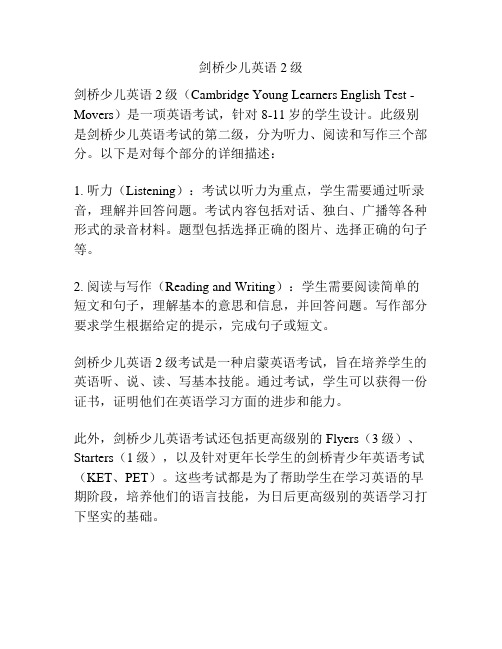
剑桥少儿英语2级
剑桥少儿英语2级(Cambridge Young Learners English Test - Movers)是一项英语考试,针对8-11岁的学生设计。
此级别是剑桥少儿英语考试的第二级,分为听力、阅读和写作三个部分。
以下是对每个部分的详细描述:
1. 听力(Listening):考试以听力为重点,学生需要通过听录音,理解并回答问题。
考试内容包括对话、独白、广播等各种形式的录音材料。
题型包括选择正确的图片、选择正确的句子等。
2. 阅读与写作(Reading and Writing):学生需要阅读简单的短文和句子,理解基本的意思和信息,并回答问题。
写作部分要求学生根据给定的提示,完成句子或短文。
剑桥少儿英语2级考试是一种启蒙英语考试,旨在培养学生的英语听、说、读、写基本技能。
通过考试,学生可以获得一份证书,证明他们在英语学习方面的进步和能力。
此外,剑桥少儿英语考试还包括更高级别的Flyers(3级)、Starters(1级),以及针对更年长学生的剑桥青少年英语考试(KET、PET)。
这些考试都是为了帮助学生在学习英语的早期阶段,培养他们的语言技能,为日后更高级别的英语学习打下坚实的基础。
剑桥国际少儿英语第二版活动用书4

剑桥国际少儿英语第二版活动用书4【中英文实用版】Section 1: Cambridge International Young Learners English Activity Book 2Section 1: 剑桥国际少儿英语第二版活动用书In this section, learners will engage in various activities that help them develop their vocabulary, grammar, and listening skills.在这一部分,学生们将参与各种活动,以帮助他们发展词汇、语法和听力技能。
The activities are designed to be fun and engaging, with the use of colorful illustrations and interactive tasks.这些活动旨在通过使用彩色插图和互动任务来吸引学生的兴趣。
For example, learners may be asked to match words to pictures, or complete sentences with the correct word order.例如,学生可能被要求将单词与图片相匹配,或用正确的单词顺序完成句子。
Through these activities, learners will improve their language skills and gain confidence in using English.通过这些活动,学生们将提高他们的语言技能,并在使用英语方面获得信心。
Section 2: Cambridge International Young Learners English Activity Book 2第二部分:剑桥国际少儿英语第二版活动用书In this section, learners will have the opportunity to develop theirreading and writing skills.在这一部分,学生们将有机会发展他们的阅读和写作技能。
剑桥少儿2级(movers)教材
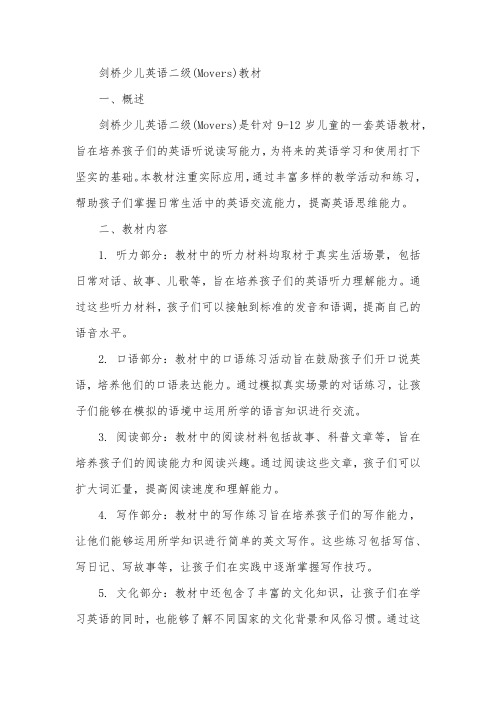
剑桥少儿英语二级(Movers)教材一、概述剑桥少儿英语二级(Movers)是针对9-12岁儿童的一套英语教材,旨在培养孩子们的英语听说读写能力,为将来的英语学习和使用打下坚实的基础。
本教材注重实际应用,通过丰富多样的教学活动和练习,帮助孩子们掌握日常生活中的英语交流能力,提高英语思维能力。
二、教材内容1. 听力部分:教材中的听力材料均取材于真实生活场景,包括日常对话、故事、儿歌等,旨在培养孩子们的英语听力理解能力。
通过这些听力材料,孩子们可以接触到标准的发音和语调,提高自己的语音水平。
2. 口语部分:教材中的口语练习活动旨在鼓励孩子们开口说英语,培养他们的口语表达能力。
通过模拟真实场景的对话练习,让孩子们能够在模拟的语境中运用所学的语言知识进行交流。
3. 阅读部分:教材中的阅读材料包括故事、科普文章等,旨在培养孩子们的阅读能力和阅读兴趣。
通过阅读这些文章,孩子们可以扩大词汇量,提高阅读速度和理解能力。
4. 写作部分:教材中的写作练习旨在培养孩子们的写作能力,让他们能够运用所学知识进行简单的英文写作。
这些练习包括写信、写日记、写故事等,让孩子们在实践中逐渐掌握写作技巧。
5. 文化部分:教材中还包含了丰富的文化知识,让孩子们在学习英语的同时,也能够了解不同国家的文化背景和风俗习惯。
通过这些知识的学习,孩子们可以更好地理解和适应跨文化交流的环境。
三、教学方法本教材的教学方法以学生为中心,注重实践和互动。
教师可以通过以下方式进行授课:1. 听力训练:教师播放听力材料,让学生听并理解,然后进行相关的听力理解练习,如选择题、填空题等。
2. 口语练习:教师组织学生进行角色扮演、小组讨论等活动,鼓励他们用英语表达自己的想法和观点,培养口语表达能力。
3. 阅读指导:教师指导学生阅读教材中的文章,让他们在阅读中学习词汇、语法和表达方式。
同时进行阅读理解练习,如问答题、选择题等。
4. 写作训练:教师提供写作题目或情境,让学生进行写作练习。
剑桥英语二年级找不同练习题
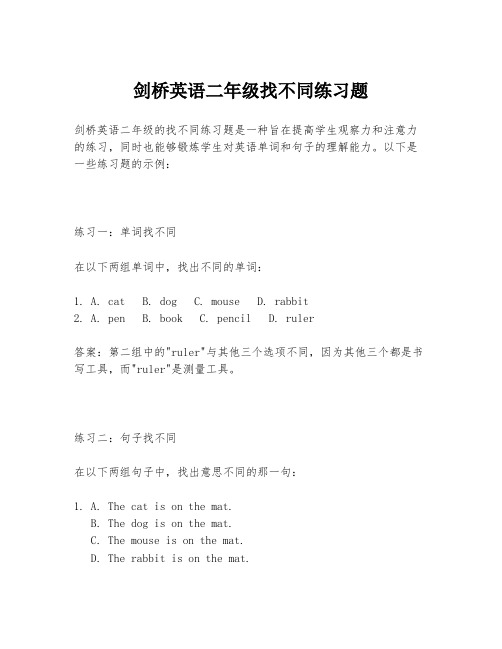
剑桥英语二年级找不同练习题剑桥英语二年级的找不同练习题是一种旨在提高学生观察力和注意力的练习,同时也能够锻炼学生对英语单词和句子的理解能力。
以下是一些练习题的示例:练习一:单词找不同在以下两组单词中,找出不同的单词:1. A. cat B. dog C. mouse D. rabbit2. A. pen B. book C. pencil D. ruler答案:第二组中的"ruler"与其他三个选项不同,因为其他三个都是书写工具,而"ruler"是测量工具。
练习二:句子找不同在以下两组句子中,找出意思不同的那一句:1. A. The cat is on the mat.B. The dog is on the mat.C. The mouse is on the mat.D. The rabbit is on the mat.2. A. She is reading a book.B. He is reading a book.C. They are reading a book.D. He is watching TV.答案:第二组中的"D. He is watching TV."与其他三个选项不同,因为其他三个选项都是关于阅读的,而"D"是关于看电视的。
练习三:图片找不同观察以下两幅图片,找出它们之间的不同之处:[图片1] 一个小男孩在公园里放风筝。
[图片2] 一个小女孩在公园里放风筝。
答案:图片中的性别不同,一个是小男孩,另一个是小女孩。
练习四:短文找不同阅读以下两段短文,找出它们之间的不同点:短文1:Tom likes to play with his toys after school. He has many cars and trucks.短文2:Tom likes to play with his toys after school. He has manycars and planes.答案:两段短文中,Tom拥有的玩具类型不同,第一段是"trucks",而第二段是"planes"。
剑桥彩虹少儿英语分级阅读 第二级别
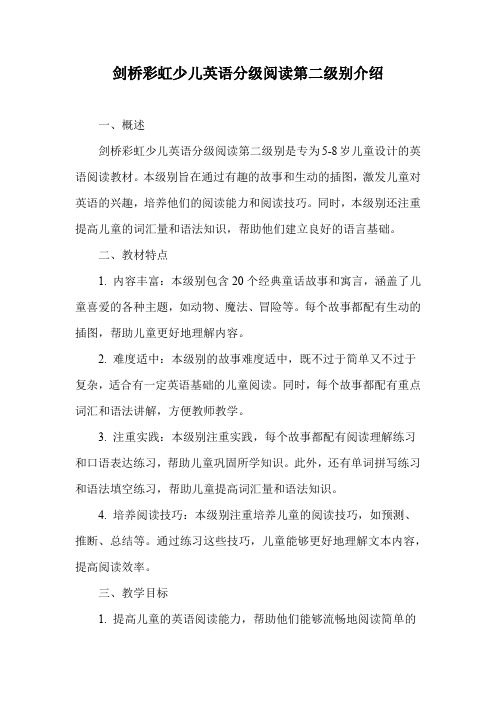
剑桥彩虹少儿英语分级阅读第二级别介绍一、概述剑桥彩虹少儿英语分级阅读第二级别是专为5-8岁儿童设计的英语阅读教材。
本级别旨在通过有趣的故事和生动的插图,激发儿童对英语的兴趣,培养他们的阅读能力和阅读技巧。
同时,本级别还注重提高儿童的词汇量和语法知识,帮助他们建立良好的语言基础。
二、教材特点1. 内容丰富:本级别包含20个经典童话故事和寓言,涵盖了儿童喜爱的各种主题,如动物、魔法、冒险等。
每个故事都配有生动的插图,帮助儿童更好地理解内容。
2. 难度适中:本级别的故事难度适中,既不过于简单又不过于复杂,适合有一定英语基础的儿童阅读。
同时,每个故事都配有重点词汇和语法讲解,方便教师教学。
3. 注重实践:本级别注重实践,每个故事都配有阅读理解练习和口语表达练习,帮助儿童巩固所学知识。
此外,还有单词拼写练习和语法填空练习,帮助儿童提高词汇量和语法知识。
4. 培养阅读技巧:本级别注重培养儿童的阅读技巧,如预测、推断、总结等。
通过练习这些技巧,儿童能够更好地理解文本内容,提高阅读效率。
三、教学目标1. 提高儿童的英语阅读能力,帮助他们能够流畅地阅读简单的英语文章。
2. 增加儿童的英语词汇量,提高他们的语法知识水平。
3. 培养儿童的阅读兴趣和阅读习惯,让他们爱上英语阅读。
4. 帮助儿童掌握基本的阅读技巧,提高他们的阅读效率和阅读理解能力。
四、教学建议1. 教师可以选择一些具有代表性的故事进行精讲,帮助学生掌握重点词汇和语法知识。
2. 对于较难的故事,教师可以适当进行背景知识的介绍和引导,帮助学生理解故事内容。
3. 鼓励学生进行课外阅读,提供一些适合他们年龄段的英文读物,让他们自主选择阅读内容。
4. 定期组织学生进行阅读分享和讨论活动,让他们有机会展示自己的阅读成果,锻炼口语表达能力。
5. 对于学生在阅读中出现的错误和问题,教师要及时给予指导和纠正,帮助他们改进和提高。
6. 在教学过程中,教师可以适当引入一些具有挑战性的任务和活动,激发学生的阅读兴趣和积极性。
剑桥国际少儿英语2 级

剑桥国际少儿英语2 级作为国际英语教育领域的知名品牌,剑桥英语一直致力于为学生提供全面的英语学习体系,并秉承着“学以致用”的教育理念,为学生带来更多实用的知识和技能。
在剑桥国际少儿英语课程中,2级的内容是学生进阶学习的重要阶段,下面我们来看看具体的内容和优势。
一、课程目标剑桥国际少儿英语2级主要涵盖了阅读、听力、口语和写作四个方面,旨在帮助学生巩固基础知识,并进一步提高语言表达能力。
具体的目标包括:1.掌握基本的英语语法和词汇;2.能够听懂和理解简单的英语口语和读物;3.能够流利地使用英语进行日常交流,包括问候、介绍、讨论话题等;4.能够进行简单的书面交流,包括填写表格、写简单的邮件等。
二、课程重点在2级的学习中,剑桥国际少儿英语主要关注以下几个方面的知识和技能:1.语法和词汇的进一步巩固:包括动词时态、名词、形容词等基本语法和基本日常词汇的巩固和复习。
2.听力和口语的提高:通过听力材料和练习,学生可以提高对于日常口语的理解和掌握,同时进行模仿练习,并通过跟同伴互动来提升日常口语表达能力。
3.阅读和写作的训练:通过简单的阅读材料和题目,学生可以扩展词汇量和提升语法应用能力;同时,进行简单的写作练习可以帮助学生建立自信心和对自己能力的认知。
三、优势掌握学生通过剑桥国际少儿英语2级的学习,可以获得以下优势:1.全方位的语言表达能力:经过阅读、听力、口语和写作的训练,学生可以全面掌握和应用基本的英语知识和技能,获得更加灵活自如的语言表达能力。
2.更加自信和独立:由于2级课程更加注重学生个体的发展和表现,会有更多课堂互动和学生个人表达机会,从而帮助学生建立自信和独立自主学习的能力。
3.具备国际化视野:剑桥国际少儿英语课程体系完全基于国际标准,学生在学习过程中,不仅可以接触到全球范围内的英语知识和文化,还能够通过实践活动深入体验不同国度的文化差异和交流切身感受。
总体来说,剑桥国际少儿英语2级课程是学生英语学习路径中的重要里程碑,既注重基础知识的巩固和提高,又突出实用性和互动性。
- 1、下载文档前请自行甄别文档内容的完整性,平台不提供额外的编辑、内容补充、找答案等附加服务。
- 2、"仅部分预览"的文档,不可在线预览部分如存在完整性等问题,可反馈申请退款(可完整预览的文档不适用该条件!)。
- 3、如文档侵犯您的权益,请联系客服反馈,我们会尽快为您处理(人工客服工作时间:9:00-18:30)。
剑桥国际少儿英语二Unit1文本Stella: Hello again! We’re the Star Family. I’m Stella Star and I’m eight. This is my brother, Simon. He’s seven, and this is my sister, Suzy. She’s four.再次向大家问好!我们是Star 一家。
我是Stella Star,我八岁了。
这是我弟弟,Simon。
他七岁了,这是我妹妹Susy,她四岁。
Simon: This is my grandmother. She’s grandma Star. 这是我的祖母,她是Grandma Star。
Grandma: Hello. 大家好。
Simon: This is my grandfather. He’s grandpa Star. 这是我的祖父,他是Grandpa Star。
Simon: Grandpa, say hello.祖父,说大家好。
Grandpa: Oh! Hello, everybody. 噢!大家好。
Mrs Star: And we’re Mr and Mrs Star.我们是Mr Star和Mrs Star。
Stella: Hello, Alex! Hello, Lenny! How are you? 你好,Alex!你好,Lenny!你们好吗?Alex and Lenny: Fine,thanks.挺好的,谢谢。
Merra: Is this your classroom,Simon? 这是你的教室吗,Simon?Simon: Yes. 是的Merra: Who’s that on the board?在板子上面的是谁?Simon: That’s my favourite toy, Maskman. Look at my Maskman ruler.那是我最喜欢的玩具,Maskman。
看我的Maskman尺子。
Lenny: That’s nice. My ruler’s on my desk.真漂亮,我的尺子在我桌子上Stella: Are your school books in the bookcase?你的课本在书柜里吗?Simon: No, they are in the cupboard. Our teacher’s here now.不,他们在柜橱里面。
咱们老师来了。
Stella and Meera: Oops。
噢Suzy: Ooh, kites! Can we look at them, Dad?哦,风筝!我们能看看吗,爸爸?Mr Star: OK, Suzy. Where are they?好的,Suzy。
他们在哪儿?Suzy: Over there! Next to the lorries. 在那儿,挨着货车。
Simon: Look at these robots! 看这些机器人!Stella: Ugh! They’re ugly!啊!他们真丑!Alex: I like this big yellow watch.我喜欢这块大的黄色手表。
Meera: Look at this camera. It’s orange, my favourite colour.看这个相机,它是橘黄色的,我最喜欢的颜色。
Stella: Hum! … Look! Computer gam es! I love computer games!嗯!看,电脑游戏!我爱电脑游戏!Simon: Great! Is there a Maskman Playbox?真棒!这是Maskman玩具箱吗?Stella: Yes, there is, and there’s a ‘Can you spell…?’ game.是的,这里还有“你会拼吗”的游戏Meera, Alex, Simon: Ugh! Stella!啊!Stella!Monty: Look at Suzy’s kite! It’s beautiful. It’s pink and purple with a long tail.看suzy的风筝!真漂亮。
它是粉色和紫色的,还有一条长尾巴。
Maskman: And it’s big, and it can fly. I can fly too. What’s that, Marie?它还很大,而且它还能飞,我也能飞。
Marie: It’s a ‘Can you spell…?’ computer game. 这是个“你会拼吗”的电脑游戏。
Monty: Whose is it? Is it Suzy’s? 这是谁的?是Suzy的吗?Marie: No, it isn’t. It’s stella’s.不,不是的,这是Stella的。
Monty: What’s that under the table?桌子下面的那是什么?Maskman: It’s Simon’s basketball.是Simon的篮球。
Monty: No, not that. What’s that new toy next to the ball?不,不是那个,那个挨着球的新玩具是什么?Marie: It’s a big robot. It’s ‘Metal Mouth’.是个大机器人,它叫“Metal Mouth”Maskman: Metal Mouth? Hmm, yes. It’s an ugly robot.Metal Mouth?嗯,是的,这是个丑机器人。
Monty: Whose is it?它是谁的?Maskman: It’s Simon’s.是Simon的。
Metal Mouth: My name is Metal Mouth. My name is Metal Mouth.我的名字叫Metal Mouth。
Monty: Ooh, look! It can walk and talk.哦,看!它可以走还可以说话。
Maskman: Yes, but it’s can’t fly. I can fly.是的,但是它不能飞,我能飞Stella: Can I play, Suzy?我可以玩玩吗,Suzy?Suzy: OK!好的!Stella: Where’s my bedroom? 我的卧室在哪儿?Suzy: It’s there, next to th e bathroom. 在这儿,挨着卫生间。
Stella: OK!Stella:好的!Suzy: Put this blue mat on the floor next to your bed.把这个蓝色的垫子放在你床边的地板上。
Stella: Can I have a phone in my bedroom?我能在我的卧室里面放一个电话吗?Suzy: No, you can’t. The phone’s in the living room next to the sofa.不,不行。
电话在客厅里,挨着沙发。
Stella: Can I have a Lamp, please?可以给我一盏灯吗?Suzy: OK. You can put the lamp on the table next to your bed.好的。
你可以把灯放在你床边的桌子上。
Stella: Thanks, Suzy. Where can I put the armchair?谢谢,Suzy。
我把椅子放在哪儿呢?Suzy: Put it in the living room under the clock.把它放在客厅的钟下面Stella: Is there a mirror in my bedroom?卧室里面有镜子吗?Suzy: A mirror in your bedroom? No, there isn’t. There are three mirrors. one in the bathroom, one in my bedroom and one in Simon’s bedroom.一个在你卧室里的镜子?不,没有。
有三个镜子,一个在卫生间,一个在我的卧室,一个在Simon的卧室。
Stella: Oh.哦。
Grandpa: Simon! Stella! Can you take your clothes to your bedrooms, please?Simon!Stella!可以请你们把你们的衣服拿回卧室吗?Simon and stella: OK!好的!Grandpa: Whose T-shirt is that? 这是谁的T恤?Stella: Which T-shirt? 哪个T恤?Grandpa: The yellow one.黄色的那个。
Stella: It’s Suzy’s.是Suzy的。
Simon: No, it isn’t. It’s mine.不,那是我的。
Stella: No, Simon. That T-shirt’s very small. Yours is the big yellow one over there.不,simon,这件T恤很小,你的是大的黄色的那件,在那边。
Simon: Oh! Yes!哦!是的!Grandpa: OK. Are those blue socks yours, Simon?好的,这些蓝色的袜子是你的吗simon?Simon: No, they aren’t mine. They are Dad’s.不,不是我的,是爸爸的。
Grandpa: What now? Oh, yes! Whose black trousers are those?那这个呢?哦,是的!这些黑色的裤子是谁的?Stella and Simon: They’re yours, Grandpa.那是你的,祖父。
Grandpa: Oh, yes! That’s right, they are.哦,是的,他们是我的。
Stella: Look, Lenny’s with Frank’s mum and dad.看,lenny和frank的爸爸妈妈。
Simon: Who’s Frank?谁是frank?Stella: Frank’s Lenny’s baby cousin. frank是lenny的小堂弟Meera: Oh, how old is he? 哦,他多大了?Stella: He’s one.他一岁了。
Simon: How many cousins have you got, Meera?你有多少个堂兄弟姐妹,meera?Meera: Six: four boys and two girls. How many cousins have you got?四个男孩和两个女孩。
